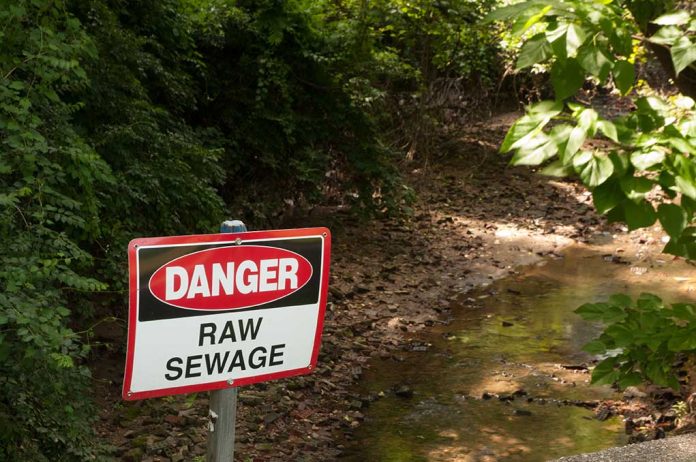
Mexico plans to dump 400 million gallons of raw sewage into the Tijuana River, threatening U.S. communities with toxic waste while federal authorities have yet to declare an emergency despite years of pollution.
Top Takeaways
- Mexico is set to release approximately 400 million gallons of untreated sewage into the Tijuana River that will flow directly into U.S. territory
- San Diego County Supervisor Jim Desmond is demanding federal intervention, stating the U.S. should not be a “dumping ground” for Mexico’s pollution
- Imperial Beach Mayor Paloma Aguirre criticizes both the Biden administration and California Governor Gavin Newsom for insufficient action on what she calls “the biggest environmental injustice in the nation”
- The contamination impacts public health, forces beach closures, and affects military training, including Navy SEALs who train in affected areas
- EPA Administrator Lee Zeldin plans to visit the area to address the crisis that has persisted for decades
Decades-Long Pollution Crisis Reaches New Heights
The Tijuana River sewage crisis, a persistent environmental disaster that has plagued the U.S.-Mexico border region for decades, is reaching a critical point as Mexican authorities prepare to release approximately 400 million gallons of raw sewage into the waterway. This planned discharge is reportedly to facilitate maintenance on Tijuana’s sewer network, but instead of implementing proper diversion methods, officials are choosing to send untreated waste directly northward into American territory. The river naturally flows from Mexico into the United States, carrying with it toxic waste and contaminants that severely impact American beaches, public health, and marine ecosystems.
San Diego County Supervisor Jim Desmond has been vocal in condemning this planned sewage release, highlighting the repeated pattern of Mexico using the United States as an environmental dumping ground. The impact is felt most severely in Imperial Beach, which has become notorious as one of America’s most polluted beaches due to the ongoing contamination. Local residents face not just the closure of recreational areas but serious health concerns from exposure to hazardous waste. The contamination is so severe that even U.S. military operations are affected, with Navy SEALs and recruits who train near the runoff area facing potential health risks.
This is what it looks like when Mexico dumps millions of gallons of raw sewage into the United States.
This isn’t just pollution, it’s a health and environmental crisis, plus a national security threat due to the proximity of the Navy Seal training.
And it’s getting worse:… pic.twitter.com/5l79u9qnVp
— Supervisor Jim Desmond (@jim_desmond) April 4, 2025
Local Officials Demand Federal Action
Frustration among local officials has reached a boiling point as they confront what they perceive as inadequate federal response to the environmental crisis. Imperial Beach Mayor Paloma Aguirre has made multiple trips to the White House seeking assistance, yet the Biden administration had declined to declare an emergency. California Governor Gavin Newsom has acknowledged the crisis during a groundbreaking ceremony for a wastewater treatment plant but has not taken the decisive action local leaders believe is necessary to address the immediate threat posed by the imminent sewage discharge.
“It’s extremely concerning that we have the largest health crisis, the biggest environmental injustice in the nation and we haven’t seen that leadership from both our state and federal governments,” said Aguirre.
Supervisor Desmond has put forward a more assertive approach, suggesting that the federal government should use its leverage over border crossings and visa approvals to pressure Mexican authorities into addressing the sewage problem. He argues that Mexican officials lack sufficient incentive to resolve the issue because they face no real consequences for their actions. The sewage problem extends beyond beaches, affecting areas near American shopping centers where the stench creates unbearable conditions for families with children and elderly residents.
“Instead of rerouting the flow during maintenance, they’re choosing the easy way out—dump it into the U.S. and make it our problem. This is unacceptable. Our communities, beaches, and environment deserve better. It’s time for federal action. We cannot continue to be the dumping ground for another country’s pollution,” said Desmond.
Potential Solutions and Ongoing Efforts
EPA Administrator Lee Zeldin is scheduled to visit the affected area to assess the situation firsthand and has called for Mexico to implement solutions quickly. The crisis has attracted attention from various levels of government, with a new wastewater treatment plant being constructed, though Mayor Aguirre has expressed skepticism about whether this facility will adequately address the scale of the problem. The recurring nature of the crisis suggests that more comprehensive and immediate solutions are required to prevent the continued environmental degradation.
The situation highlights broader issues of international environmental responsibility and the challenges of cross-border pollution management. As the planned sewage discharge approaches, residents on the American side of the border face uncertainty about the potential health impacts and the duration of beach closures and other restrictions. Without immediate intervention and long-term solutions that address the root causes of the pollution, communities along the U.S.-Mexico border will continue to bear the environmental and public health burden of this ongoing crisis.






















